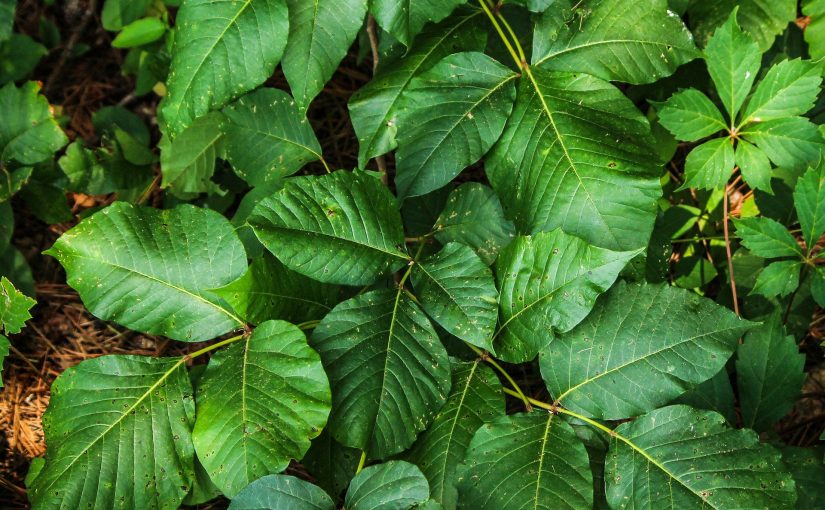Nobody wants to spend several weeks of their summer with an irritatingly itchy, unsightly and often times painful rash. But the truth is, this can happen by simply touching one toxic plant: Poison Ivy. Keep reading to find out the best herbal remedies for poison ivy and ensure that it does not ruin your summer!
How Does Poison Ivy Affect You?
Poison Ivy contains a resin like substance called Urushiol. This is the compound that will cause an allergic reaction in between 50-85% of all people exposed to any part of the plant. The ivy itself can grow as a vine or a shrub and is usually found in woodland areas, meadows or yards near the woods. In Maine, I’ve only seen it as a low lying vine. Once you identify it in the wild, it gets easier to spot. I find the shiny leaves in groups of three on a vine to be a tell-tale sign.
Standard medical practice is to apply calamine lotion (make your own Calamine lotion here) and cold compresses. If the case is considered severe (i.e. more than 1/3 of the body is affected or there is facial or throat swelling), prednisone may be prescribed.
Over the centuries, however, many herbal remedies have been developed, handed down and used effectively in treating the irritating and sometimes painful rash. Here are some of the best known herbal remedies for Poison Ivy:
Best Herbal Remedies for Poison Ivy
Kloss Liniment
A Liniment is basically just a tincture you have made or bought that is used externally, instead of taking the drops internally. For rashes and poison ivy, you can have a spray bottle in your home or car that can be quickly and easily used to spray on any areas affected. It can also be put into a soothing, room temperature or cooler bath.
The anti-inflammatory effects of cayenne, the astringent and microbial actions of the Myrrh, and the antibiotic properties of Echinacea and Goldenseal will all help to reduce oozing, spreading, itching and inflammation.
Kloss Liniment Ingredients:
1 part Organic Echinacea powder
1 part Organic Goldenseal powder (please us cultivated, the wild herb has been seriously over-harvested) or 1 part Spikenard powder
1 part Myrrh powder
¼ part Cayenne powder
Rubbing Alcohol
Directions:
Depending on how much you want made (this stuff lasts a long time), put all your powdered herbs into a glass container. If you have whole herbs, you can powder them by grinding them in a coffee grinder, a high speed blender, or an old fashioned mortar and pestle.
Once the herbs are in, fill the bottle with rubbing alcohol, leaving 2 inches of liquid at the top. Leave it in a warm spot for about a month. Then strain using a few layers of cheesecloth or an unbleached coffee filter and rebottle (you can use a glass bottle of any kind with a lid, or pour it into a clean spray bottle).
Aloe Vera Gel
Aloe can be very soothing to the inflamed rash. You can apply it directly onto the skin from a broken leaf (they sell it in many grocery stores’ produce departments), or you can buy some from most markets. The Aloe may relieve the burning sensations of the rash and speed up the recovery.
Goldenseal Bath
To prevent infection, wash effected areas (in a bathtub is effective) with a decoction of goldenseal powder. To make this, simmer 1T/15ml of the powder in 2 quarts of water for 30 minutes. Cool and apply.
Grindelia
By applying the tincture of this herb straight onto the rash, the itching and inflammation may be reduced significantly and quickly, according to many anecdotal reports. It’s also calming to the nervous system which can help relax the person affected with poison ivy.
Jewelweed
Probably the most well known herbal remedies for poison ivy, this herb often grows in the same areas as poison ivy. Not only can it help to relieve the irritation of the rash, but it can even prevent a breakout if applied quickly after coming into contact with poison ivy. A stem can be broken off and the ‘juice’ applied directly. This counteracts the chemicals in poison ivy that irritate the skin.
By harvesting the flowers and leaves, a tea can be made and cooled to soothe and help prevent spreading. Rosemary Gladstar, a well loved and respected herbalist, came up with the idea of putting the tea into ice trays. Then the herbal ice cubes are used to soothe and help heal the rash. Many people have said this works wonderfully.
What to do if You Get a Poison Ivy Rash
Remember, scratching the rash and then touching other body parts can cause rapid spreading. If you have a poison ivy rash, be sure to wash it and your hands (or any body part coming into contact) thoroughly. Use the hottest water you can stand. Dr. Andrew Weil suggests that applying hot water each time the itching starts can significantly speed up the entire allergic reaction cycle.
Also, completely change clothes as soon as possible. Wash the exposed clothing in several hot cycles with laundry soap and baking soda and/or apple cider vinegar.
We all hope that we can avoid poison ivy forever. But in case you accidentally brush by some on your next hike, you now have a reference to guide you. Now you are familiar with the best herbal remedies for poison ivy. Use them to care for that rash and minimize your suffering.

